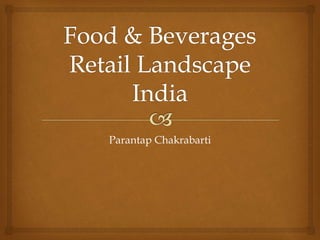Food & Beverages Retail Landscape India
- 2. Food retailing forms about 61% of the total retail. The value of food retail has been expressed as a sum of contributions towards Food and Beverages. Size of food retail in 2008-09 was Rs. 10700 billion. Retail Landscape Food&Beverages Rest
- 3. Organised food retailing has a share of only 1.44% of the total size of food retailing. But the organised food retail is growing at nearly 150% as that of food retailing on the back of favourable drivers such as high disposable income, growing proportion of youth in overall population, gradual increase in share of population living in urban areas and increasing proportion of enrollment of women employees into the job market. Organised vs. Unorganised Food Retail Organised Unorganised
- 4. Food retailing is essential but not very profitable for organized retailers Issues of perishability, shrinkage, wastage and dealing with a large number of small suppliers besides volatile and rising prices greatly increased costs and risks and reduced returns. However quality and range in food retailing meant regular customer footfalls. The long term implication of this is that the food part can be entirely outsourced to a supply chain specialist company under a profit sharing arrangement.
- 5. Survey conducted in A1 and A class cities show that the largest group of customers (60%) have low preference for organized retailer when it comes to food. Also about 60% unorganized retailers in class A and 38% in class B cities reported increase in turnover in the last one to two years. The classification of class A and B cities based on population - CLASSIFICATION POPULATION A-1 Above 50 lakhs A 20-50 lakhs B-1 10-20 lakhs B-2 5-10 lakhs C 50,000-5 lakhs
- 6. Unorganised retailer's choice of cost control over scale has endured them well during slow-down. The cost structure of unorganised retailer is in the range of 5-8% of the turnover, taking into consideration rent as well as cost of own labour. In case of organised retail , the cost structure varies between 17%-25% of the turnover. Higher cost structure is mainly on account of higher rental, higher employee costs, logistics cost, and costs due to shrinkage, wastage etc. Low cost structure and control over costs have enabled unorganised food retailers to survive.
- 7. The statistics of retail outlets in India is as follows -








